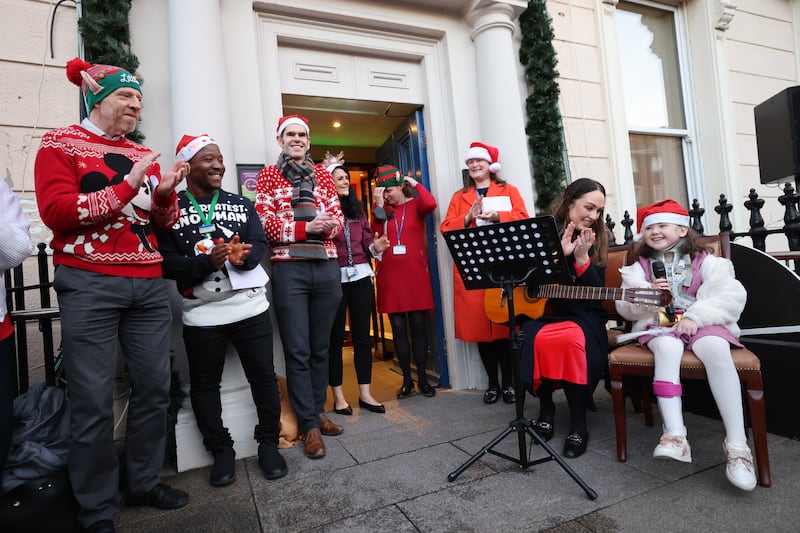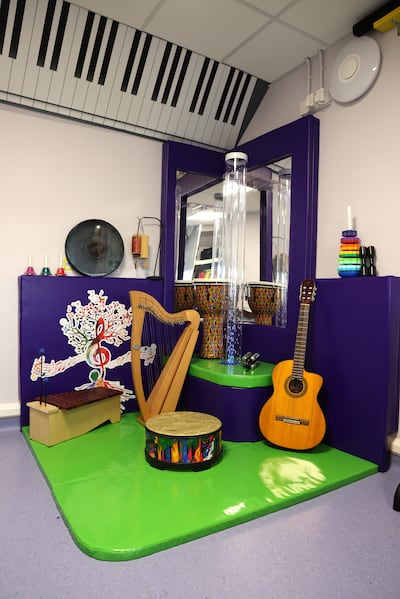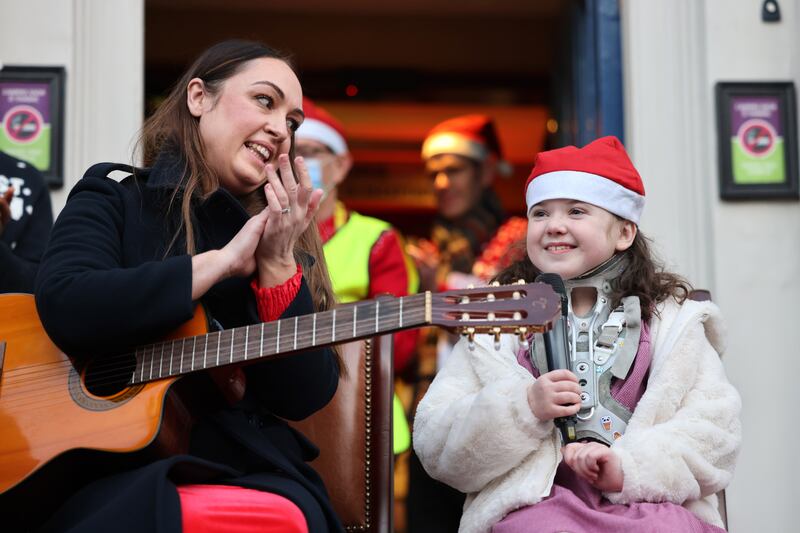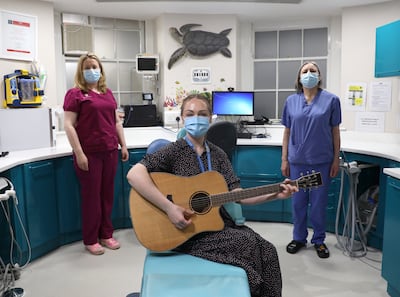Saoibh Lonergan was such a hit on this year’s Late Late Toy Show, with her repartee and the heartstring-pulling song she wrote in hospital, that the delightful 10-year-old she was invited back on the regular Late Late Show the following week, with her parents.
During both appearances, wearing a back brace over her dress, she talked lovingly of Alison, a music therapist in Children’s Health Ireland at Temple Street. “I feel like she was one of the people who knowed me the most,” she told the show’s host, Ryan Tubridy. Saoibh had surgery at the hospital last July to remove a tumour in her spinal canal and is now recovering in the National Rehabilitation Hospital, in Dún Laoghaire. But she was back at Temple Street this month to perform a duet with Alison at the switching on of the Christmas lights.
“You’d nearly get jealous [of] how good herself and Alison get along,” jokes Saoibh’s father, Kenny. He and his wife, Orla, were a bit doubtful when they first met Alison with a box of instruments at the hospital bedside of their daughter, “who couldn’t walk, she could barely move her body. It’s hard to look at someone telling you to shake a rattle when your child is the way she is,” says Kenny.
“Alison asked Saoibh could she sing a song, and sure Saoibh was telling her she was at Ed Sheeran, and she started singing Afterglow.” Saoibh joined in. “From that minute on, our view changed on music therapy, and they clicked. It was amazing. I don’t think Saoibh would have recovered as quick – that’s my take on it,” he says.
READ MORE

Alison Sweeney, to give this music therapist her full name, is delighted with the publicity – not for herself, she says, but for her profession, which she reckons the general public know little, if anything, about. “It was a wonderful moment to have the words ‘music therapist’ used on The Late Late Show, just incredible,” she says in a video call from the music-therapy room on the third floor of the Temple Street hospital, where she has worked for eight years. Tightening of infection controls at the hospital amid the surge of paediatric winter illness has kept this writer at a safe distance.
So how does she explain her job? “Music therapy is a clinical profession, with a large evidence base to support its use,” she says. While she has specialised in acute paediatric care and works with the neuro-rehab and palliative care teams in the hospital, it is a therapy that is used across the lifespan. Essentially, the music is a motivator towards reaching health goals.
Take, for example, a child who has suffered loss of movement in their upper limbs. They may not want to do the stretches being prescribed for their recovery, but put them in front of drum kit “and they absolutely want to play that drum”, she says. Suddenly the therapeutic stretches come naturally.
For a child struggling to regain communication skills after a brain injury, Alison will use familiar songs or nursery rhymes, leaving “lyric blanks” for them to fill. Repetition of words is so much easier in a singalong than in ordinary speech.
She devises individualised music therapy programmes to engage each child referred to her, in conjunction with other health professionals involved in their care such as speech and language therapists, occupational therapists and physiotherapists. Now she also attends the hospital’s monthly dental clinics, in a pilot project that is breaking new ground, they believe, as they are not aware of anything similar elsewhere in Ireland or the UK.
It is remarkable how introducing patient-preferred music into that setting can really help to manage the anxiety
“You would imagine that [it] is about distraction but it’s not,” she says. Rather, it is about giving the young people a sense of control during their treatment. “I meet young people in the waiting room and speak to them about their musical preference. We have a chat about the way we can use music once we enter the dental surgery to cope with the experience.
“Typically, these would be young people who may have complex medical needs and procedural anxiety. So I go in and work closely with our dental surgeon and dental nurse. It is remarkable how introducing patient-preferred music into that setting can really help to manage the anxiety.”
But central to all forms of her work is the emotional needs of the child. “How are they coping with the experience of being in hospital? What can we do as music therapists to support positive coping?” Songwriting, as Saoibh demonstrated, gives young people an outlet to express their experience of illness.
“A lot of the young people I work with are very unwell, so some of the sessions will be at their bedside,” says Alison. But once they are well enough they can go up to the music therapy room, which is funded through Children’s Health Foundation and equipped with a huge number of instruments, including a row of guitars, an electric piano and drum kit, and fitted out with multisensory lighting and padded areas.
It should be enjoyable – hospital is tough enough. For us, it is finding those little moments of joy, of fun, and making it as creative as possible for them
“Most of the time young people come in here the word they have in their mouth is ‘wow’,” she says. “It’s just such a lovely escape from the ward. It should be enjoyable – hospital is tough enough. For us, it is finding those little moments of joy, of fun, and making it as creative as possible for them.”
Having a dedicated room is a huge bonus, particularly when working therapeutically with adolescents. If they happen to be in a four-bed unit, it’s extremely difficult for them to express themselves freely when surrounded by three other families, she says.
“The fact we have this room gives young people privacy. It has really revolutionised what we can offer,” says Alison, who is one of four – soon to be five – music therapists working for Children’s Health Ireland in Crumlin and Temple Street hospitals. Her interest in music therapy developed after she had graduated from University College Cork with a music degree and was working in performance as a pianist, singer and songwriter.
“I met a young person with an intellectual disability and he loved music. I was fascinated at the way he engaged with music and it got me thinking about how everybody accesses music in their own way.” There was also a close family friend, a GP and psychotherapist, who was always encouraging her and asked her if she had thought about music therapy.
As soon as Alison started reading case studies, “I thought, this is for me. I was hooked on it.” She did the two-year, full-time master’s course in music therapy at the University of Limerick – currently the only way to qualify as a professional music therapist on the island of Ireland.

After graduating from there nearly 11 years ago, she spent a long time on the road, working for a day with one organisation and then a day with another. “I really had to go out and sell the concept of music therapy. The funny thing about it is once people see music therapy in action, that’s it, they’re on board.” Its value is being increasingly recognised within healthcare.
“Things have changed so much, even in the last five years. We are now seeing advertisements for music therapy posts and 10 years ago that was unheard of.”
Clinical work and music for pleasure go hand in hand for Alison. She still performs in her spare time. “It keeps you very fresh in terms of your musical repertoire. Working in an acute hospital, you can be asked for any kind of song: rap, hip hop, the very latest in the charts. You need to be able to make a good attempt at them pretty quickly.”
While having good music skills is important, she also likes to sit down at the piano and write songs for herself. “That is absolutely therapeutic for me and always has been. Even after a really busy day of making music with young people, being able to go home and play music for myself, it’s lovely.”
Christmas Day is one of her favourite days of the year in Temple Street hospital. On arrival she will head straight to the music therapy room but it’s not about therapy that morning, simply spreading a little musical joy. “I am collecting instruments and tuning guitars – people always hear me before they see me.”
She will be part of a team that goes from ward to ward, child to child, singing Christmas carols with parents, children and the staff. “I am one of the really lucky people who get this lovely morning with all the families” but then can leave at about 1.30pm to drive home to Co Laois “and have my dinner served up to me”, with her parents, family and husband. “Obviously a lot of our patients and the staff don’t get to do that.”

Saoibh is having a two-week break from her Monday to Friday stints at the National Rehabilitation Hospital to be at home in Tramore, Co Waterford, with her parents and two brothers over Christmas. The plan is she will then return and continue to attend the NRH until January 27th, when they will assess her progress.
“She can walk but her right leg is affected; she gets tired and she wears a splint on that. Her left arm doesn’t operate the way it used to either.” Despite her ordeal this year, she’s the same happy girl, says Kenny, but again, he puts this down to the music therapy.
Saoibh was always into music and drama but he reckons the collaborative songwriting – she and Alison have composed four songs together – has brought her another step forward. For an hour a day with Alison, “Saoibh could just be Saoibh, without having to get up and walk and jump around”, says Kenny, who can’t speak highly enough of the only music therapist they’ve ever met. But he acknowledges that, no doubt, there are many others applying the same sort of healing skills.
“There were days Saoibh wouldn’t get out of the bed and we would just say, ‘Alison is coming down the hall’, and she’d hop up into the wheelchair and go up to Alison’s room. It was the only hour in the hospital that no one was poking at her and she could be herself.”

A little light music therapy to try at home
Alison always encourages parents of infants to sing to their babies. You should not let lack of confidence in your singing abilities hold you back.
Research shows the positive impact that rhythm, repetition and rhyme have on the developing brain, especially in terms of language acquisition.
“We know that infants are innately attracted to the musical characteristics of the speech, all the contours of speech. My advice is sing to your baby; holding your baby and gently rocking back and forth provides extra sensory regulating input. Incorporate singing simple nursery rhymes into different aspects of the baby’s day, whether that’s nappy changes, feeds or bedtime.”
For older children it’s just about having fun with music. “Be silly with your child. Dance to music, kitchen discos are great fun.” Even just listening to music can allow for lovely moments of bonding, she says.
If you can, give your child the chance to learn to play a musical instrument. “Not everybody has to be a professional musician but the process of training the brain to read music notation and to engage creatively is very beneficial.”
For more information about music therapy see Irish Association of Creative Arts Therapists












